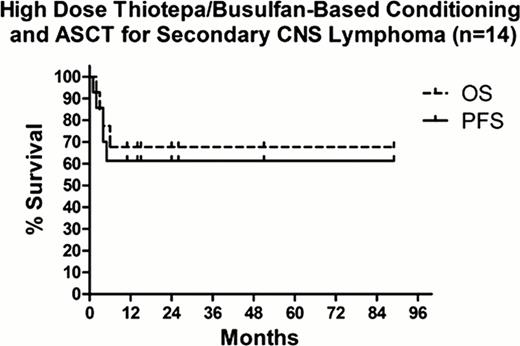Abstract
Abstract 2003
Secondary CNS Lymphoma (SCNSL) is relatively rare, but associated with median survival of less than 4 months following conventional therapies. In an effort to improve upon these poor results, the Calgary ASCT Program has offered HDTB/ASCT to referred SCNSL patients who have good performance status, adequate organ function, and chemosensitive disease. The purpose of this study was to retrospectively review outcomes of these pts. In total, 14 pts aged 40–67 years (median 58) with SCNSL were transplanted in Calgary from 1997–2012 (9 pts from 2010–2012). Twelve pts experienced CNS progression after completing (n=9) or while still receiving (n=3) initial systemic therapy. The median time to progression (TTP) from initiation of systemic therapy was 6 months (mo, range 1– 132) for these 12 pts. Only one patient had received CNS prophylaxis with intrathecal chemotherapy. In addition to these 12 pts, 2 pts had SCNSL coincidental with initial diagnosis of systemic lymphoma. Histology included diffuse-large B-cell lymphoma in 12 pts (including one intravascular lymphoma and two transformed from prior indolent lymphoma), plasmablastic in 1 pt, and peripheral T-cell lymphoma NOS in 1 pt. Sites of CNS involvement included: brain=6,meninges=5, brain+meninges=1, meninges+eye=1, intramedullary spinal cord=1. High risk features for CNS relapse of initial systemic lymphoma presentation (N=12) included elevated LDH (n=7/10), extranodal disease (END, n=12/12), >1 site END (n=6/12), ECOG 2–4 (n=5/10), IPI 3–5 (n=7/10). At the time of HDTB/ASCT, 7 pts had isolated CNS disease and 7 pts had CNS and systemic lymphoma. Pre-ASCT CNS directed therapy included intrathecal (IT) methotrexate (MTX) alone (n=1), IT MTX plus whole brain radiotherapy (n=1), IT MTX plus high dose intravenous MTX (n=1), high dose MTX plus cytarabine or DHAP (n=10), R-HyperCVAD (n=1). Disease status at HDTB/ASCT was complete response (n=1), partial response (n=13). Prior to 2011 (n=7) high dose therapy involved: thiotepa 300mg/m2.
IV days -8 and -7, busulfan 3.2 mg/kg IV daily on days -6, -5, -4, and cyclophosphamide 2 g/m2.
IV days -3 and -2, followed by ASCT on day 0 (TBC). After 2011 (n=7), high dose therapy involved: rituximab 375 mg/m2 day -7, thiotepa 250 mg/m2 day -6,-5, busulfan 3.2 mg/kg IV daily on days -4, -3, -2, melphalan 100mg/m2IV on day -1, followed by ASCT on day 0 (RTBM). At a median follow-up of 15 months (range 2–89), projected 2-year PFS is 61% and OS 68%. One pt died of treatment-related encephalopathy and pneumonia 4mo post-ASCT, 3 pts died of relapsed systemic lymphoma 2–6mo after TBC/ASCT, 1 pt with plasmablastic lymphoma is currently alive but with relapsed disease 5mo post RTBM/ASCT, and 9 pts are alive and relapse free. The figure below illustrates a possible plateau on PFS and OS curves for the 14 treated pts.
HDTB/ASCT offers a potentially curative approach in selected patients with SCNSL.
Off Label Use: In Canada, all the TBC and RTBM drugs are off label (ie no Health Canada NOC indication) for CNS lymphoma. Stewart:Honorarium for advisory board, Otsuka America Pharmaceutical, Inc. Rockville, Maryland: Honoraria.


